
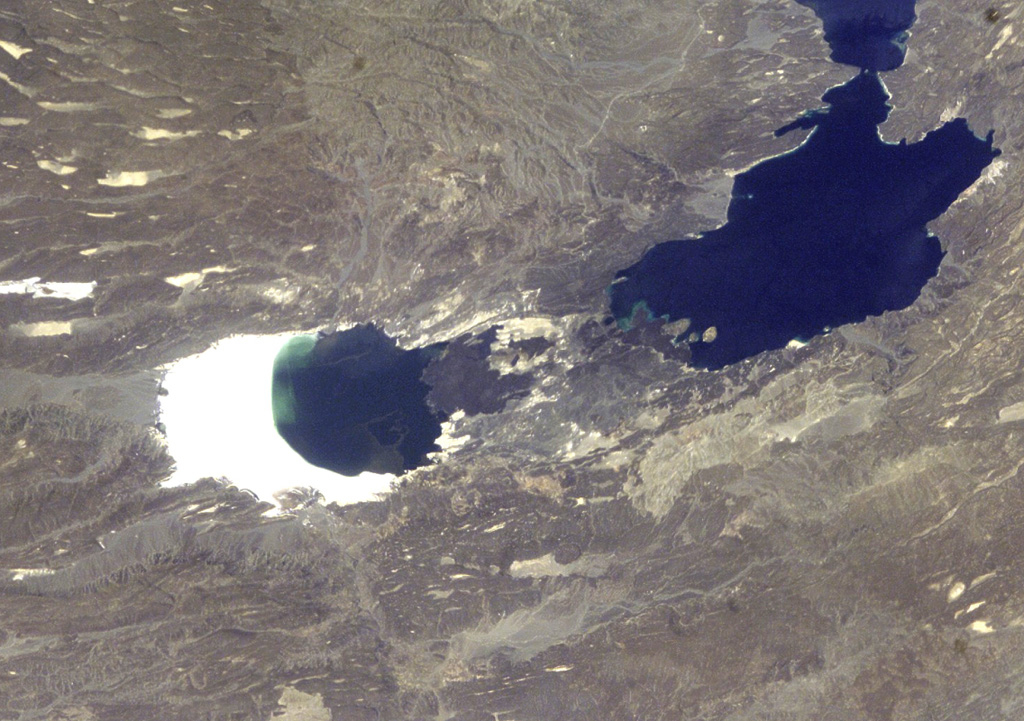
New data on November eruption
The eruption of Ardoukoba began on 7 November. During the preceding 24 hours, about 800 earthquakes M < 3.3 had been recorded. These events occurred at the end of the Ghoubbat al Kharab (figure 2), just S of the rift and ~6 km SE of the eruption site.
After a brief period of gas emission, lava fountaining began from a 500-m-long, newly opened fissure. Three spatter cones formed on this fissure, but the primary activity soon shifted about 1/2 km to the SE. For the first 2-4 hours as much as 0.5 x 106 m3 of lava was extruded per hour, but the extrusion rate declined rapidly and by the 5th or 6th day had decreased by an order of magnitude.
By 9 November, only the main vent was still active. A cone (named Gira-le-Koma) about 30 m high, 200 m long, and 25 m wide, with a 60° external slope, had formed around this vent, which contained a small lava lake. On 13 November the level of the lava lake dropped rapidly, then the lake disappeared. Scoria and bombs were ejected briefly before the eruption ended on 14 November.
The total volume of lava emitted was estimated to be at least 12 x 106 m3. Lava covered an area of slightly more than 3 km2. Flow thicknesses reached 25 m but usually ranged from 1 to 2 m. About 25 fissures, parallel to the NW-SE trend of the rift, opened during the activity. Most fissures were from 1-2 mm to about 1 m wide, but there was one short segment of 3 m width. Many of the fissures also showed a component of normal movement, with scarps up to 1/2 m high.
Reference. Needham and others, 1976, The accreting plate boundary: Ardoukoba Rift (northeast Africa) and the oceanic rift system: Earth and Planetary Science Letters, v. 28, p 439-453.
Further References. Abdallah, A., and others, 1979, Relevance of Afar seismicity and volcanism to the mechanics of accreting plate boundaries: Nature, v. 282, p. 17-23.
Demange, J., and Tazieff, H., 1978, The "tectonic" eruption of the Ardoukoba (Djibouti): C.R. Acad. Sci. Paris, Ser. D, v. 287, p. 1269-1272.
Hernandez, J., and Ruegg, J.C., eds., 1980, Colloque Rift d'Asal: Réunion extraordinaire de la Société Géologique de France: Bulletin de la Societé Géologique de France, serie 7, t. XXII, no. 6, p. 797-1013.
Tarantola, A., Ruegg, J.C., and Lepine, J.C., 1979, Geodetic evidence for rifting in Afar: A brittle-elastic model for the behavior of the lithosphere: Earth and Planetary Science Letters, v. 45, p. 435-444.
Information Contacts: M. Krafft, Cernay.
The Global Volcanism Program has no Weekly Reports available for Ardoukôba.
Reports are organized chronologically and indexed below by Month/Year (Publication Volume:Number), and include a one-line summary. Click on the index link or scroll down to read the reports.
Basaltic lava flows; first eruption in as much as 3,000 years
The crew of a French observation aircraft saw an eruption early 8 November in a virtually uninhabited area SE of Lake Assal. On the preceding day a series of weak earthquakes was felt in the city of Djibouti and two larger shallow events were located by the U. S. Geological Survey's National Earthquake Information Center (USGS/NEIC). The first, mb 5.2, occurred on 7 November at 2006 (felt as a sharp shock in Djibouti) and the second, mb 5.0, on 8 November at 0808. Hypocenters calculated by the USGS for these events are 8 and 17 km WSW of the eruption, or well within the location error for events in this region.
Two basaltic lava flows were reportedly extruded: one flow traveled ~1 km to the SE, the other ~0.5 km to the NW. Lava effusion rates reached an estimated maximum of 1,000 m3/minute [but see 0.5 x 106 m3/hour below]. Ash clouds rose ~300 m and larger pyroclastics ~70 m. The eruption formed a crater ~30 m in diameter and built a cone ~100 m high.
Activity began to decline 14 November and within two days only steaming was visible. As of 22 November, some vapor emission continued from subsidiary vents. No casualties or damage were reported.
The Ardoukoba (Asal) Rift in Djibouti (figure 1), trending NW from the Red Sea, contains a broad area of youthful fissure vents between Lake Asal and the Ghoubbat al Kharab gulf. Although no previous eruptions have been reported in the area in historic time, the most recent lava flows are substantially younger than sediments 14C dated at 5,300 B.P., and are thought to be younger than 3,000 B.P. Eruptions are also mentioned in local legends (Delibrias and others, 1975).
Reference. Delibrias, G., Marinelli, G., and Stieltjes, L., 1975, Spreading rate of the Asal Rift, in Pilger, A. and Rosler, A. (eds.), Afar Depression of Ethiopia: Inter-Union Commission on Geodynamics Scientific Report No. 14: E. Schweitzerbart'sche Verlagsbuchhandlung, Stuttgart.
Information Contacts: W. Clarke, U.S. Embassy, Djibouti; M. Krafft, Cernay, France; USGS/NEIC.
New data on November eruption
The eruption of Ardoukoba began on 7 November. During the preceding 24 hours, about 800 earthquakes M < 3.3 had been recorded. These events occurred at the end of the Ghoubbat al Kharab (figure 2), just S of the rift and ~6 km SE of the eruption site.
After a brief period of gas emission, lava fountaining began from a 500-m-long, newly opened fissure. Three spatter cones formed on this fissure, but the primary activity soon shifted about 1/2 km to the SE. For the first 2-4 hours as much as 0.5 x 106 m3 of lava was extruded per hour, but the extrusion rate declined rapidly and by the 5th or 6th day had decreased by an order of magnitude.
By 9 November, only the main vent was still active. A cone (named Gira-le-Koma) about 30 m high, 200 m long, and 25 m wide, with a 60° external slope, had formed around this vent, which contained a small lava lake. On 13 November the level of the lava lake dropped rapidly, then the lake disappeared. Scoria and bombs were ejected briefly before the eruption ended on 14 November.
The total volume of lava emitted was estimated to be at least 12 x 106 m3. Lava covered an area of slightly more than 3 km2. Flow thicknesses reached 25 m but usually ranged from 1 to 2 m. About 25 fissures, parallel to the NW-SE trend of the rift, opened during the activity. Most fissures were from 1-2 mm to about 1 m wide, but there was one short segment of 3 m width. Many of the fissures also showed a component of normal movement, with scarps up to 1/2 m high.
Reference. Needham and others, 1976, The accreting plate boundary: Ardoukoba Rift (northeast Africa) and the oceanic rift system: Earth and Planetary Science Letters, v. 28, p 439-453.
Further References. Abdallah, A., and others, 1979, Relevance of Afar seismicity and volcanism to the mechanics of accreting plate boundaries: Nature, v. 282, p. 17-23.
Demange, J., and Tazieff, H., 1978, The "tectonic" eruption of the Ardoukoba (Djibouti): C.R. Acad. Sci. Paris, Ser. D, v. 287, p. 1269-1272.
Hernandez, J., and Ruegg, J.C., eds., 1980, Colloque Rift d'Asal: Réunion extraordinaire de la Société Géologique de France: Bulletin de la Societé Géologique de France, serie 7, t. XXII, no. 6, p. 797-1013.
Tarantola, A., Ruegg, J.C., and Lepine, J.C., 1979, Geodetic evidence for rifting in Afar: A brittle-elastic model for the behavior of the lithosphere: Earth and Planetary Science Letters, v. 45, p. 435-444.
Information Contacts: M. Krafft, Cernay.
|
|
||||||||||||||||||||||||||
There is data available for 1 confirmed Holocene eruptive periods.
1978 Nov 7 - 1978 Nov 14 Confirmed Eruption (Explosive / Effusive) VEI: 1
| Episode 1 | Eruption (Explosive / Effusive) | ||||||||||||||||||||||||||||||||||||||||||||||||||
|---|---|---|---|---|---|---|---|---|---|---|---|---|---|---|---|---|---|---|---|---|---|---|---|---|---|---|---|---|---|---|---|---|---|---|---|---|---|---|---|---|---|---|---|---|---|---|---|---|---|---|
| 1978 Nov 7 - 1978 Nov 14 | Evidence from Observations: Reported | |||||||||||||||||||||||||||||||||||||||||||||||||
|
List of 8 Events for Episode 1
|
||||||||||||||||||||||||||||||||||||||||||||||||||
This compilation of synonyms and subsidiary features may not be comprehensive. Features are organized into four major categories: Cones, Craters, Domes, and Thermal Features. Synonyms of features appear indented below the primary name. In some cases additional feature type, elevation, or location details are provided.
Cones |
||||
| Feature Name | Feature Type | Elevation | Latitude | Longitude |
| Baddi Koma | Tuff cone | 11° 33' 0.00" N | 42° 32' 0.00" E | |
| Gira-le-Koma | Cone | |||
| Kodda Ginni Koma | Tuff cone | 11° 32' 0.00" N | 42° 32' 0.00" E | |
| Ounda Ginna Koma | Tuff cone | 11° 33' 0.00" N | 42° 32' 0.00" E | |
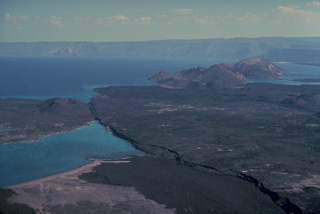 The Ardoukôba (Asal) Rift in Djibouti, trending NW from the Red Sea, contains a broad area of youthful fissure vents between Lake Asal and the Ghoubbat al Kharab gulf. This view looks from the north towards the gulf. Regional faults of the Ardoukôba Rift trending NW-SE cut lava-flow fields. A cinder cone appears at the left, and a group of tuff cones lie at the upper right. The youngest lava flows cover lake sediments deposited 5300 years ago. An eruption in 1978 produced a small cinder cone and lava flows.
The Ardoukôba (Asal) Rift in Djibouti, trending NW from the Red Sea, contains a broad area of youthful fissure vents between Lake Asal and the Ghoubbat al Kharab gulf. This view looks from the north towards the gulf. Regional faults of the Ardoukôba Rift trending NW-SE cut lava-flow fields. A cinder cone appears at the left, and a group of tuff cones lie at the upper right. The youngest lava flows cover lake sediments deposited 5300 years ago. An eruption in 1978 produced a small cinder cone and lava flows.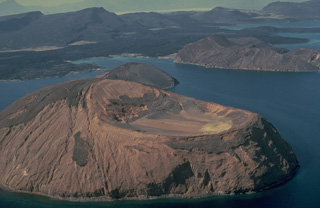 The three tuff cones of Kodda Ginni Koma (foreground), Ounda Ginna Koma (the small island in the center), and Baddi Koma (upper right) were formed when rising magma along the Ardoukoba Rift encountered waters of the Ghoubbat al Kharab gulf of the Red Sea. Fresh lava flows in the background were erupted from the parallel NW-SE-trending fissures of Ardoukôba volcano in the country of Djibouti. Tilted fault blocks in the background dip to the SW and NE, away from the center of the rift valley.
The three tuff cones of Kodda Ginni Koma (foreground), Ounda Ginna Koma (the small island in the center), and Baddi Koma (upper right) were formed when rising magma along the Ardoukoba Rift encountered waters of the Ghoubbat al Kharab gulf of the Red Sea. Fresh lava flows in the background were erupted from the parallel NW-SE-trending fissures of Ardoukôba volcano in the country of Djibouti. Tilted fault blocks in the background dip to the SW and NE, away from the center of the rift valley.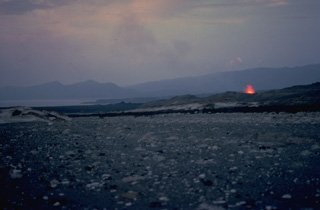 A lava fountain at the right rises from a 500-m-long fissure at Ardoukôba. This view looks from the NNW to the Ghoubbat al Kharab gulf of the Red Sea in the distance. About 25 fissures parallel to the NW-SE trend of the Ardoukôba Rift opened during the eruption, but eruptive activity was localized on a single rift. Lava flows from the 1978 eruption covered 3.2 km2 of the rift floor.
A lava fountain at the right rises from a 500-m-long fissure at Ardoukôba. This view looks from the NNW to the Ghoubbat al Kharab gulf of the Red Sea in the distance. About 25 fissures parallel to the NW-SE trend of the Ardoukôba Rift opened during the eruption, but eruptive activity was localized on a single rift. Lava flows from the 1978 eruption covered 3.2 km2 of the rift floor.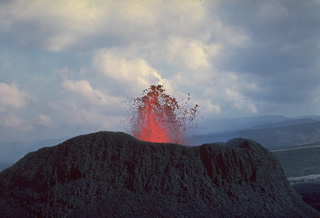 A small cinder cone ejects spatter during the first historical eruption of the Ardoukôba (Asal) Rift, which took place November 7-14, 1978. Lava fountaining occurred from a 500-m-long fissure. Several spatter cones and a cinder cone were formed along the fissure, which fed lava flows that covered about 3 km2 of the rift floor.
A small cinder cone ejects spatter during the first historical eruption of the Ardoukôba (Asal) Rift, which took place November 7-14, 1978. Lava fountaining occurred from a 500-m-long fissure. Several spatter cones and a cinder cone were formed along the fissure, which fed lava flows that covered about 3 km2 of the rift floor. 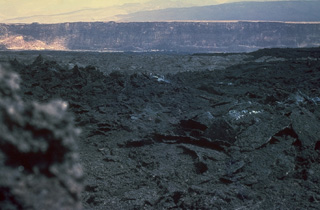 The dark aa lava flow in the foreground was produced during an eruption on the Arkdoukôba Rift November 7-14, 1978. This photo from the SW looks across the rift during the eruption and shows one of the regional NW-SE-trending faults of the rift in the background. Lava flows from the 1978 eruption covered about 3 km2 of the rift floor, primarily on the north side of the eruptive fissure.
The dark aa lava flow in the foreground was produced during an eruption on the Arkdoukôba Rift November 7-14, 1978. This photo from the SW looks across the rift during the eruption and shows one of the regional NW-SE-trending faults of the rift in the background. Lava flows from the 1978 eruption covered about 3 km2 of the rift floor, primarily on the north side of the eruptive fissure. The Ardoukôba (Asal) Rift in the center of the photo lies in Djibouti and trends NW from the Red Sea. Ardoukoba contains a broad area of youthful fissure vents between Lake Asal (bounded by white saline deposits at the left) and the Ghoubbat al Kharab gulf (upper right). The most recent lava flows are younger than lake sediments deposited 5,300 years ago. The Ardoukôba fissure erupted in 1978, producing a small cinder cone and lava flows that covered part of the rift floor near the Red Sea.
The Ardoukôba (Asal) Rift in the center of the photo lies in Djibouti and trends NW from the Red Sea. Ardoukoba contains a broad area of youthful fissure vents between Lake Asal (bounded by white saline deposits at the left) and the Ghoubbat al Kharab gulf (upper right). The most recent lava flows are younger than lake sediments deposited 5,300 years ago. The Ardoukôba fissure erupted in 1978, producing a small cinder cone and lava flows that covered part of the rift floor near the Red Sea.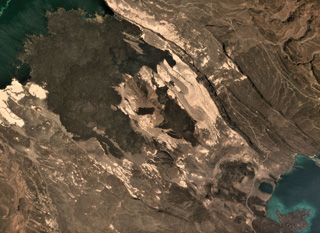 The Ardoukôba Rift is in Djibouti at the NW end of Lake Ghoubet (lower right) and is shown in this October 2019 Planet Labs satellite image monthly mosaic (N is at the top; this image is approximately 11 km across). It contains lava flows from scoria and spatter cones, with recent deposits erupted in 1978.
The Ardoukôba Rift is in Djibouti at the NW end of Lake Ghoubet (lower right) and is shown in this October 2019 Planet Labs satellite image monthly mosaic (N is at the top; this image is approximately 11 km across). It contains lava flows from scoria and spatter cones, with recent deposits erupted in 1978.There are no samples for Ardoukôba in the Smithsonian's NMNH Department of Mineral Sciences Rock and Ore collection.
| Copernicus Browser | The Copernicus Browser replaced the Sentinel Hub Playground browser in 2023, to provide access to Earth observation archives from the Copernicus Data Space Ecosystem, the main distribution platform for data from the EU Copernicus missions. |
| MIROVA | Middle InfraRed Observation of Volcanic Activity (MIROVA) is a near real time volcanic hot-spot detection system based on the analysis of MODIS (Moderate Resolution Imaging Spectroradiometer) data. In particular, MIROVA uses the Middle InfraRed Radiation (MIR), measured over target volcanoes, in order to detect, locate and measure the heat radiation sourced from volcanic activity. |
| MODVOLC Thermal Alerts | Using infrared satellite Moderate Resolution Imaging Spectroradiometer (MODIS) data, scientists at the Hawai'i Institute of Geophysics and Planetology, University of Hawai'i, developed an automated system called MODVOLC to map thermal hot-spots in near real time. For each MODIS image, the algorithm automatically scans each 1 km pixel within it to check for high-temperature hot-spots. When one is found the date, time, location, and intensity are recorded. MODIS looks at every square km of the Earth every 48 hours, once during the day and once during the night, and the presence of two MODIS sensors in space allows at least four hot-spot observations every two days. Each day updated global maps are compiled to display the locations of all hot spots detected in the previous 24 hours. There is a drop-down list with volcano names which allow users to 'zoom-in' and examine the distribution of hot-spots at a variety of spatial scales. |
|
WOVOdat
Single Volcano View Temporal Evolution of Unrest Side by Side Volcanoes |
WOVOdat is a database of volcanic unrest; instrumentally and visually recorded changes in seismicity, ground deformation, gas emission, and other parameters from their normal baselines. It is sponsored by the World Organization of Volcano Observatories (WOVO) and presently hosted at the Earth Observatory of Singapore.
GVMID Data on Volcano Monitoring Infrastructure The Global Volcano Monitoring Infrastructure Database GVMID, is aimed at documenting and improving capabilities of volcano monitoring from the ground and space. GVMID should provide a snapshot and baseline view of the techniques and instrumentation that are in place at various volcanoes, which can be use by volcano observatories as reference to setup new monitoring system or improving networks at a specific volcano. These data will allow identification of what monitoring gaps exist, which can be then targeted by remote sensing infrastructure and future instrument deployments. |
| Volcanic Hazard Maps | The IAVCEI Commission on Volcanic Hazards and Risk has a Volcanic Hazard Maps database designed to serve as a resource for hazard mappers (or other interested parties) to explore how common issues in hazard map development have been addressed at different volcanoes, in different countries, for different hazards, and for different intended audiences. In addition to the comprehensive, searchable Volcanic Hazard Maps Database, this website contains information about diversity of volcanic hazard maps, illustrated using examples from the database. This site is for educational purposes related to volcanic hazard maps. Hazard maps found on this website should not be used for emergency purposes. For the most recent, official hazard map for a particular volcano, please seek out the proper institutional authorities on the matter. |
| IRIS seismic stations/networks | Incorporated Research Institutions for Seismology (IRIS) Data Services map showing the location of seismic stations from all available networks (permanent or temporary) within a radius of 0.18° (about 20 km at mid-latitudes) from the given location of Ardoukôba. Users can customize a variety of filters and options in the left panel. Note that if there are no stations are known the map will default to show the entire world with a "No data matched request" error notice. |
| UNAVCO GPS/GNSS stations | Geodetic Data Services map from UNAVCO showing the location of GPS/GNSS stations from all available networks (permanent or temporary) within a radius of 20 km from the given location of Ardoukôba. Users can customize the data search based on station or network names, location, and time window. Requires Adobe Flash Player. |
| DECADE Data | The DECADE portal, still in the developmental stage, serves as an example of the proposed interoperability between The Smithsonian Institution's Global Volcanism Program, the Mapping Gas Emissions (MaGa) Database, and the EarthChem Geochemical Portal. The Deep Earth Carbon Degassing (DECADE) initiative seeks to use new and established technologies to determine accurate global fluxes of volcanic CO2 to the atmosphere, but installing CO2 monitoring networks on 20 of the world's 150 most actively degassing volcanoes. The group uses related laboratory-based studies (direct gas sampling and analysis, melt inclusions) to provide new data for direct degassing of deep earth carbon to the atmosphere. |
| Large Eruptions of Ardoukôba | Information about large Quaternary eruptions (VEI >= 4) is cataloged in the Large Magnitude Explosive Volcanic Eruptions (LaMEVE) database of the Volcano Global Risk Identification and Analysis Project (VOGRIPA). |
| EarthChem | EarthChem develops and maintains databases, software, and services that support the preservation, discovery, access and analysis of geochemical data, and facilitate their integration with the broad array of other available earth science parameters. EarthChem is operated by a joint team of disciplinary scientists, data scientists, data managers and information technology developers who are part of the NSF-funded data facility Integrated Earth Data Applications (IEDA). IEDA is a collaborative effort of EarthChem and the Marine Geoscience Data System (MGDS). |